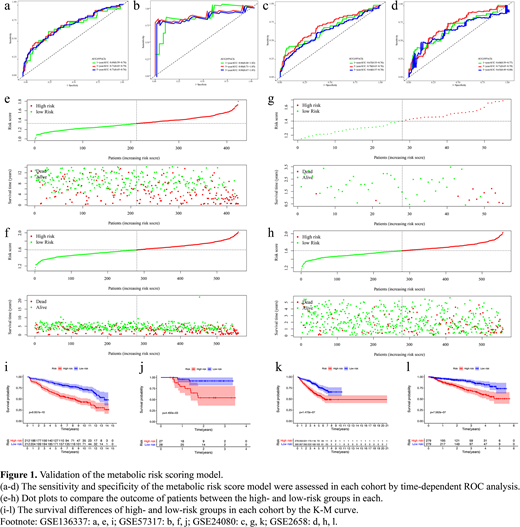Background: Models to predict survival of persons with plasma cell myeloma are mostly use clinical and laboratory co-variates including cytogenetics and mutation topography. These models have AUCs of 0.55 to 0.77 indicating considerable inaccuracy. We tested whether data of plasma cell metabolism might improve prediction accuracy.
Methods: RNA matrix, clinical and laboratory data from datasets GSE13633 (training cohort) and GSE57317, GSE24080 and GSE2658 (validation cohorts) were downloaded from the Gene Expression Omnibus (GEO) database. Genes regulating plasma cell metabolism correlating with survival were identified in uni-variable Cox regression analyses and a metabolic risk score built by Lasso Cox regression analysis. Survivals was compared by Kaplan-Meier curves with log-rank tests. Prediction accuracy of the metabolic risk score was quantified by time-dependent receiver operating characteristic (ROC) curves and the area under the curve. A nomogram was developed including metabolic risk score and ISS stage. Enriched pathways in different metabolic risk score cohorts were evaluated by gene set enrichment analyses (GSEA). We interrogated validity of 3 genes with the largest risk coefficients in vitro using small molecule inhibitors to test effects on cell proliferation and apoptosis by CCK-8 and multi-parameter flow cytometry (MPFC).
Results: 7 genes regulating plasma cell metabolism with high risk coefficients were used to develop a metabolic risk score. The score had robust predictive performance with AUCs for 3-year survival in the 4 cohorts of 0.71 [95% Confidence Interval, 0.65, 0.79], 0.88 [0.71, 1.03], 0.70 [0.63,0.76] and 0.71 [0.65, 0.79]. Subjects in the high‐risk cohort had worse 3-year survivals compared with those in the low‐risk cohort (62% [55, 68%] vs. 85% [80, 90%], P < 0.001; 54% [33, 76%] vs. 92% [82, 102%], P <0.001; 58% [52, 65%] vs. 77% [71, 82%], P <0.001; and 51% [38, 64%] vs. 74% [62, 85%], P <0.001). The metabolic risk score remained an independent prognostic factor for survival in multi-variable regression analyses. A nomogram combining metabolic risk score with ISS score increased prediction accuracy of 5-year survival (AUCs of 0.72 [0.69,0.81] vs. 0.66 [0.60, 0.72]; P = 0.015). In GSEA most gene enrichment pathways in high-risk cohort were metabolism-related. In vitro, the results showed that the three small molecule inhibitors combined with bortezomib had a synergistic inhibitory effect on the growth of myeloma cells H929, MM.1S, U266B1 and RPMI 8226, with an effective synergistic CI value; and enhanced the apoptosis of myeloma cell lines effect.
Conclusion: A risk score based on expression of genes involved in plasma cell metabolism predicted survival and significantly improved prediction accuracy of the ISS score. Predictions based on gene expression were validated in vitro.
Keywords
GEO, plasma cell myeloma, metabolism, prognostic model
No relevant conflicts of interest to declare.
Author notes
Asterisk with author names denotes non-ASH members.


